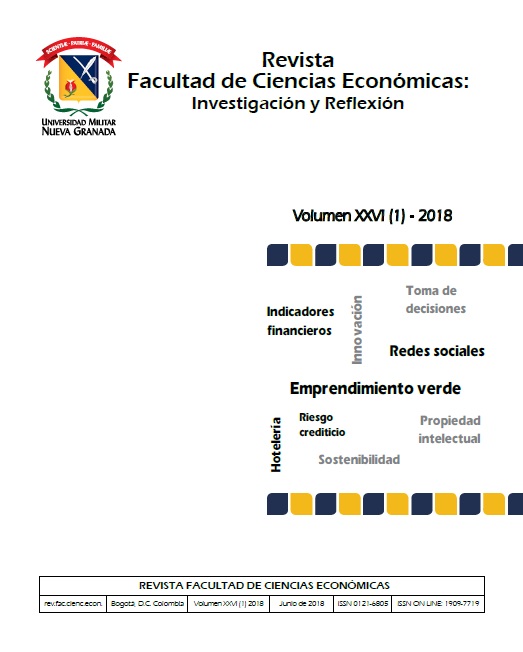Intellectual property rights (IPR) and economic growth: a review
Abstract
This article analyzes the effects of Intellectual Property Rights (IPR) on the economic growth of countries, where greater protection encourages innovation processes that affect the greater advance of production. In the analytical development of work, Romer's (1991) endogenous growth model is taken as a theoretical framework, which explains the foundations of how knowledge formation leads economies to raise their levels of development. To give support to the above, is found in the literature, different works in which the importance of the IPR has been proven. Finally, taking a sample of countries between 1990 and 2014, it is concluded that spending on knowledge formation complemented by greater IPR protection leads to greater economic growth per capita, but the main thing turns out to be spending on R & D and not human capital defined as the percentage of the population with higher education.Downloads
References
Alliance, P. R. (2014). International Property Rights Index. 2014 Report. Property Rights Alliance, Washington, DC. Recuperado de http://internationalpropertyrightsindex.org/about
Acevedo, M. L., Afonso, O., & Silva, S. T. (2012). Intellectual Property Rights and Endogenous Economic Growth-Uncovering the Main Gaps in the Research Agenda. INTECH Open Access Publisher.
Barro, R. J., & I Martin, X. S. (2009). Crecimiento económico. Barcelona: Reverté.
BBC (2015) Martin Shkreli: ¿es éste el hombre más odiado de Estados Unidos? Recuperado de http://www.bbc.com/mundo/noticias/2014/05/140502_finde_economia_costo_nuevas_drogas_aa.shtml
Benavides, G., Óscar, A. & Forero, P. (2002). Crecimiento endógeno: conocimiento y patentes. Revista de Economía Institucional, 4(6), 109-131.
Casas-Herrera, J., & Barichello, R. (2015). Hacia una noción sobre la pobreza. APUNTES DEL CENES, 34(59), 39-62. doi:https://doi.org/10.19053/22565779.2784
Caviedes. C., & Fuentes. H. (2011). Acuerdos de propiedad intelectual: ¿Nos acercan al desarrollo?. Apuntes del CENES, 30(51), 141-164.
CECTE (2008). Ética en el acceso al conocimiento de dominio público. Recuperado de http:// www.mincyt.gob.ar/_post/descargar.php?idAdjuntoArchivo=44273
Chen, Y. & T. Puttitanun (2005). Intellectual property rights and innovation in developing countries. Journal of Development Economics, 78(2): 474-493. http://dx.doi.org/10.1016/j.jdeveco.2004.11.005
Chomsky, N. (2000). La sociedad global. Educación, mercado y democracia.
Corsani, A. (2004). Hacia una renovación de la economía política. Antiguas categorías e innovación tecnológica. En Blondeau, O., & Sánchez Cedillo, R. (1 Ed) Capitalismo cognitivo: propiedad intelectual y creación colectiva. Madrid: Traficantes de Sue-os. (pp. 89 -98)
Cozzi, G. (2009). Intellectual Property, innovation, and growth: introduction to the special issue. Scottish Journal of Political Economy, 56(4), 383-389. http://dx.doi.org/10.1111/j.1467-9485.2009.00490.x
Gadbaw, R. M., & Richards, T. (1988). Intellectual property rights. Global consensus, global conflict.
Ginarte, J.C. y W.G. Park (1997). Intellectual Property Rights and Economic Growth. Contemporary Economic Policy, XV: 51-61.
Gould, D.M. & Gruben, W.C., (1996). The role of intellectual property rights in economic growth. Journal of Development Economics 48: 323–350. http://dx.doi.org/10.1016/0304-3878(95)00039-9
Grossman, G. M., & Helpman, E. (1993). Endogenous innovation in the theory of growth. National Bureau of Economic Research NBER Working Paper No. w4527. http://dx.doi.org/10.3386/w4527
Guzmán, A. (2000). Las fuentes endógenas del crecimiento económico. Economía Teoría y Práctica: 35-60. Recuperado de: http://www.izt.uam.mx/economiatyp/numeros/numeros/13/articulos_PDF/13_2_Las_fuentes_endogenas.pdf
Lelarge, C. (2012). Innovación y los derechos de propiedad intelectual. En OCDE. Innovación en las empresas. Foro consultivo científico y tecnológico. (pp 201-245) Recuperado de http://www.foroconsultivo.org.mx/libros_editados/innovacion_empresas.pdf
Lerner, J. (2000). 150 years of patent protection. National bureau of economic research No. w7478. https://doi.org/10.3386/w7478
Lucas, R. (1988). On the mechanics of Economic Development. Journal of Monetary Economics, 22(1): 3-42. http://dx.doi.org/10.1016/0304-3932(88)90168-7
Iwaisako, T., & Futagami, K. (2013). Patent protection, capital accumulation, and economic growth. Economic Theory, 52(2), 631-668. http://dx.doi.org/10.1007/s00199-011-0658-y
Park, W. G. (2008). International patent protection: 1960–2005. Research policy, 37(4): 761-766. http://dx.doi.org/10.1016/j.respol.2008.01.006
Posada, C. E. (2015). El costo de oportunidad del cambio técnico, el crecimiento económico y el caso colombiano 1925-2012. Ensayos sobre Política Económica, 33(77), 149-167. https://doi.org/10.1016/j.espe.2015.04.002
Rapp, R. T., & Rozek, R. P. (1990). Benefits and costs of intellectual property protection in developing countries. Journal of world trade, 24(5): 75-102.
Rebelo, S. T. (1991). Long run policy analysis and long run growth. National Bureau of Economic Research NBER Working Paper No. 3325. http://dx.doi.org/10.1086/261764
Richardson, R. S., & Gaisford, J. D. (1996). North-South disputes over the protection of intellectual property. The Canadian Journal of Economics/Revue canadienne d'Economique, 29, S376-S381. http://dx.doi.org/10.2307/136071
Roffe, P., & Santacruz, M. (2006). Los derechos de propiedad intelectual en los acuerdos de libre comercio celebrados por países de América Latina con países desarrollados. CEPAL.
Romer, P. M. (1983). Dynamic competitive equilibria with externalities, increasing returns and unbounded growth. Doctoral dissertation, University of Chicago, Department of Economics.
Romer, P. M. (1987). Growth based on increasing returns due to specialization. The American Economic Review, 77(2): 56-62.
Romer, P. M. (1991). El cambio tecnológico endógeno. El trimestre económico, 441-480.
Romer, P. M. (1994). The origins of endogenous growth. The journal of economic perspectives, 8(1): 3-22. http://dx.doi.org/10.1257/jep.8.1.3
Rosales, R.A, J.A Perdomo, C.A Morales & J. A Urrego (2010). Fundamentos de econometría intermedia: teoría y aplicaciones. Apuntes de clase CEDE. Universidad de los Andes.
Solow, R. (1957). Technical change and the aggregate production function. Review of Economics and Statistics, 39(3): 312-320. http://dx.doi.org/10.2307/1926047
Taylor, M. S. (1994). TRIPS, trade, and growth. International Economic Review, 35(2): 361-381. http://dx.doi.org/10.2307/2527058
Vercellone, C. (2004). Las políticas de desarrollo en tiempos del capitalismo cognitivo. En Emanuel Rodríguez y Raúl Sánchez, (Compiladores.), Capitalismo cognitivo, propiedad intelectual y creación colectiva (pp. 63-74). Traficantes de Sue-os.
Sala-i-Martin, X. (2000). Apuntes de crecimiento económico. Antoni Bosch Editor.
Vallejo-Zamudio, L. (2017). El incierto crecimiento económico colombiano. APUNTES DEL CENES, 36(64), 9-10. doi:https://doi.org/10.19053/01203053.v36.n64.2017.6511
Young, A. A. (1928). Increasing returns and economic progress. The economic journal, 38(152): 527-542. http://dx.doi.org/10.2307/2224097
Zerda, A. (2005a). Ética y conocimiento. El caso de la negociación del TLC Colombia – USA. Cuadernos Del Doctorado. Ética, Salud Y Vida. En:Colombia ISBN: 958-701-540-1 ed: Universidad Nacional de Colombia , v.1 , p.23 – 34 Recuperado de http://www.doctoradosaludp.unal.edu.co/images/cuadernos/cuaderno1.pdf
Zerda, A. (2005b). Impacto de las provisiones TRIPS–Plus contempladas en el TLC Colombia–Estados Unidos. Serie LATN Papers (Latin American Trade Network), (41).
Zerda, Á., Cortés, M., De la Hoz, G., Muriel, D., Marcela, D., & Forero, D. (2005c). Impactos del Tratado de Libre Comercio Colombia-Estados Unidos en el sector salud del distrito capital. Investig. segur. soc. salud, (7), 69-94











